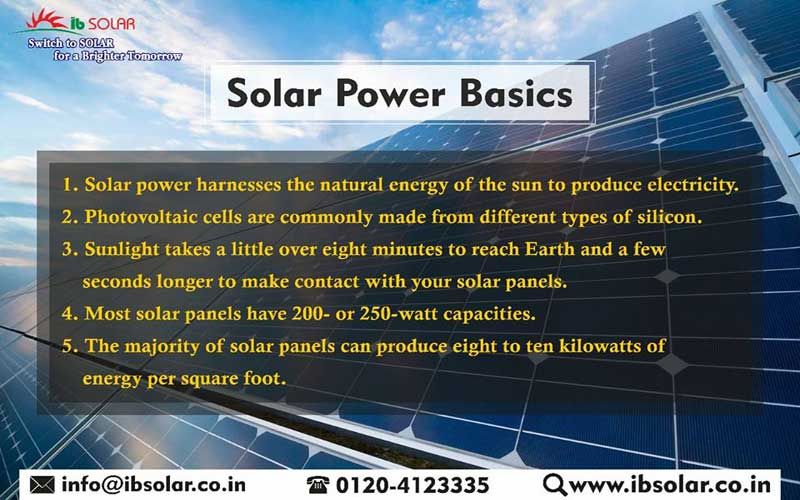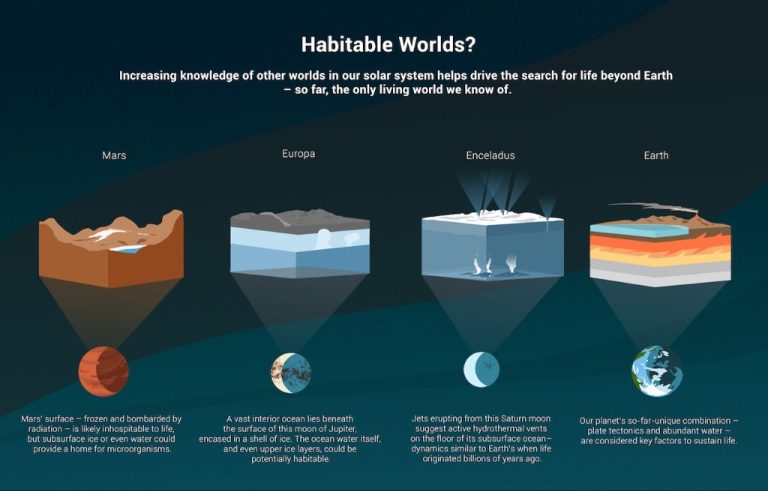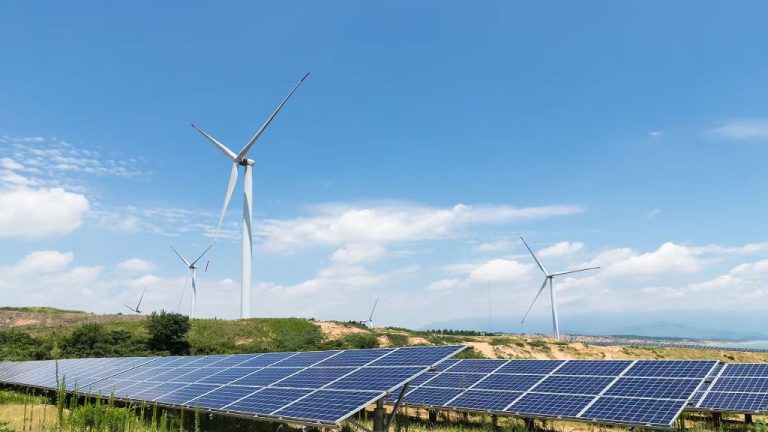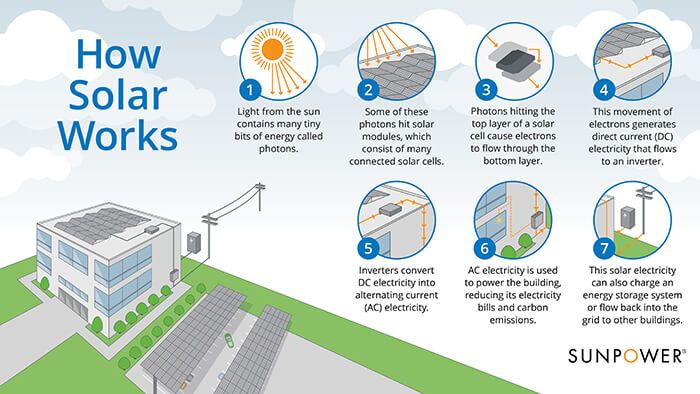What Is The Basic Information About Solar Power?

Solar power is the conversion of energy from sunlight into electricity. Solar energy is a renewable energy source as it comes from the sun. Humans have harnessed solar power for thousands of years, starting with passive solar techniques like orienting buildings towards the sun for heating and lighting (https://www.nrel.gov/research/re-solar.html). The modern photovoltaic solar cell was invented in 1954, providing a way to convert sunlight directly into electricity.
Today, solar power provides clean, renewable electricity around the world. Solar energy offers many benefits compared to fossil fuels, including reducing air pollution, combating climate change, and providing energy access. As solar panel costs have fallen 89% over the last decade, solar power capacity has expanded over 200 times to over 580 gigawatts worldwide as of 2018 (https://justenergy.com/blog/introduction-to-solar-power/). Solar power will continue growing in importance as countries and companies transition to carbon-free energy sources.
How Solar Panels Work
Solar panels work through the photovoltaic effect, which is a process that converts sunlight into electricity. When sunlight hits the solar panel, it excites the electrons in the solar cells, causing them to flow and generate an electric current (Nationalgrid.com, 2023).
Solar cells are made up of silicon, which is a semiconductor that has both positively charged and negatively charged layers. Sunlight knocking electrons loose allows current to flow from the negatively charged layer to the positively charged layer, generating electricity (Nationalgrid.com, 2023).
The current generated flows into metal conductive plates on the solar cell, allowing the electricity to be captured and utilized. Individual solar cells are connected together to form solar panels, which increases the amount of electricity that can be produced (Nationalgrid.com, 2023).
Types of Solar Panels
There are three major types of solar panels used in residential and commercial installations: monocrystalline, polycrystalline, and thin-film.
Monocrystalline solar panels are made from a single crystal of silicon, giving them a distinctive black appearance and high efficiency ratings of around 15-20%. According to Energysage, monocrystalline panels are best suited for residential rooftop systems when space is limited. Monocrystalline panels do tend to be more expensive than other types due to higher silicon purity levels [1].
Polycrystalline solar panels are made from fragments of silicon crystals melted together, giving them a speckled blue appearance and slightly lower efficiency ratings of around 13-16%. According to Aurora Solar, polycrystalline panels are a good option for larger utility-scale projects where panel size and weight are less of an issue. Polycrystalline panels are cheaper to produce than monocrystalline [1].
Thin-film solar panels use very thin layers of photovoltaic material deposited on glass or stainless steel. Thin-film panels have lower efficiency ratings of 7-13% but cost less. They can be made to be flexible and transparent. Thin-film works well when integrated into building materials but takes up more space for the wattage produced [2].
Residential Solar Power Systems
A typical home solar power system consists of solar panels installed on the roof that convert sunlight into electricity, an inverter that converts the DC power from the panels into AC power for household use, and a net meter that tracks energy use and credits excess solar energy fed back into the grid (Energy.gov, 2022).
The main pros of residential solar power systems are reducing your electricity bills, increasing your home’s value, earning tax credits and incentives, and minimizing your environmental impact. The average solar system saves homeowners 50-70% on their electricity bill (Energy.gov, 2022). Installing solar panels can increase your home’s value by about 4.1% on average, which means solar panels can be a smart investment as well (Energy.gov, 2022).
The main cons are the upfront costs, which can range from $15,000-$25,000 for an average-sized system. Maintenance costs are also a factor, as the inverter may need replacement after 10-15 years and panels may show decreased output over decades of use (Energy.gov, 2022). Apartment dwellers and renters are often not able to install solar panels themselves.
Overall, residential solar power systems can provide decades of free electricity from the sun after recouping the initial investment through electricity bill savings and incentives. For homeowners looking to save money and help the environment, solar panels are an increasingly attractive option.
Utility Scale Solar Power
Utility scale solar power refers to large-scale solar photovoltaic (PV) systems that generate electricity and feed it directly into the electric grid, supplying utility companies with renewable energy. These systems are usually ground-mounted solar arrays built on open land over 1 megawatt (MW) in capacity, ranging from 5 MW to over 500 MW.
The main advantage of utility scale solar is the ability to generate clean renewable electricity at a large capacity to meet utility demands. According to the Solar Energy Industries Association (SEIA), as of 2020 there was over 40 gigawatts of installed utility-scale solar capacity in the United States, with over 100 gigawatts in the pipeline [1]. The average utility scale system size in 2019 was 105 MW.
The costs of utility scale solar have dropped dramatically in the past decade, making it highly cost competitive with fossil fuels. According to NREL, average installed costs for fixed-tilt utility-scale PV systems fell from around $3 per watt in 2010 to $1 per watt in 2019 [2]. The levelized cost of energy from solar PV is now on par or lower than coal and natural gas.
Major solar farms can generate hundreds of megawatts of power using millions of PV panels spread across thousands of acres of land. Top examples include the 579 MW Solar Star project in California, the 550 MW Topaz Solar Farm in California, and the 400 MW Ivanpah Solar Electric Generating System in the Mojave Desert.
Solar Energy Storage
Storing solar energy allows homes and businesses to use solar power even when the sun isn’t shining (SEIA, 2019). There are two main ways to store solar energy:
Batteries
Batteries like the Tesla Powerwall (https://www.tesla.com/powerwall) can store excess solar energy during the day to be used at night. Battery storage allows solar panel systems to provide backup power during grid outages. Battery costs have fallen significantly in recent years, making home solar battery systems more affordable.
Thermal Storage
Thermal energy storage involves heating or cooling a storage medium like water or molten salt with excess solar heat, which can then heat water or generate electricity on demand. This allows solar thermal power plants to dispatch electricity when needed (Energy.gov, 2021).
Challenges
Despite decreasing costs, energy storage still adds significant expense to solar power systems. Interconnection standards and regulations for grid-tied solar-plus-storage systems are still developing in many regions. Reliability and system complexity also remain challenges.
Solar Power and the Environment
Solar power has several environmental advantages compared to fossil fuel power plants. Solar panels generate electricity without emitting greenhouse gases that contribute to climate change. According to the Energy Information Administration, the life-cycle global warming emissions associated with solar panels are over 10 times lower per kilowatt-hour than fossil fuel power plants.
However, solar power does have some potential environmental impacts. Solar farms can take up large amounts of land, although this land can often still be used for agriculture or grazing. The Energy Information Administration notes that utility-scale solar only requires 3.4 acres per megawatt, compared to coal which needs 43 acres.
There are also concerns around the toxic materials like lead and cadmium used in some solar panels. Proper solar panel disposal and recycling is important to prevent these materials from contaminating soil and water. Most solar panels can be recycled today. According to the Solar Energy Industries Association, over 90% of the materials in solar panels, including glass, plastics, and metals, can be reused or recycled.
Solar Policy and Incentives
There are a variety of policies and incentives aimed at encouraging solar adoption in the United States. One of the most impactful has been the federal solar Investment Tax Credit (ITC). The ITC allows homeowners to deduct 26% of the cost of installing a residential solar energy system from their federal taxes through 2022. The deduction drops to 22% in 2023 before expiring completely for residential projects in 2024 [1]. Many states also offer additional solar incentives such as rebates and tax credits that can further reduce the cost of going solar [2].
Net metering policies have also played a major role in the adoption of rooftop solar. Net metering allows solar panel owners to get credit for excess electricity they export to the grid. This enables them to offset the cost of power drawn from the grid when their panels aren’t generating enough, such as at night. As of 2020, 40 states had mandatory net metering rules in place [3].
Renewable portfolio standards (RPS) that mandate utilities to source a portion of their electricity from renewables like solar have further driven growth. As of 2021, 30 states and Washington D.C. had RPS policies ranging from 10-100% renewable energy targets [4]. These policies create renewable energy demand that incentivizes solar deployment.
Future of Solar Power
The future looks bright for solar power. Much research is focused on improving the efficiency of existing solar photovoltaic technologies, as well as developing new technologies such as perovskite solar cells and solar concentrators (MIT Energy Initiative). Experts predict solar panel efficiency will continue to increase by around 0.5% each year, though new breakthroughs could accelerate that timeline (NREL).
Solar power capacity is also expected to grow rapidly, from around 580 gigawatts globally in 2019 to as much as 8,500 gigawatts by 2050 according to projections by the International Renewable Energy Agency. This is driven by plummeting prices for solar panels and improved energy storage capabilities to overcome solar’s intermittent nature. If growth projections hold true, solar could generate up to 20% of global electricity by 2027 and as high as 45% by 2050 (IRENA).
With solar technology improving and costs dropping each year, the future is bright for this renewable energy source to play a major role in powering the planet and mitigating climate change.
Common Misconceptions
Despite the many benefits of solar power, there are still some common myths and misconceptions that cause confusion and hesitation around adopting it. Let’s debunk some of the most prevalent solar myths.
Myth: Solar only works when the sun is shining
Reality: Solar panels can still produce electricity even on cloudy days, just at reduced output. And any excess solar electricity produced during the day is often stored in batteries for use at night. Many solar systems are also connected to the electric grid, allowing homes to draw power when needed (Energy.gov).
Myth: Solar is only for rich people
Reality: While solar does require high upfront costs, solar panel prices have dropped dramatically in recent years. Plus there are incentives like tax credits to offset costs. Financing options can make solar affordable for most homeowners today (EnergySage).
Myth: Solar panels don’t last long
Reality: Solar panels are incredibly durable and typically come with 20-25 year warranties. Most will last well beyond that. Solar manufacturers test panels under extreme conditions to ensure decades of performance (Performance Services).





